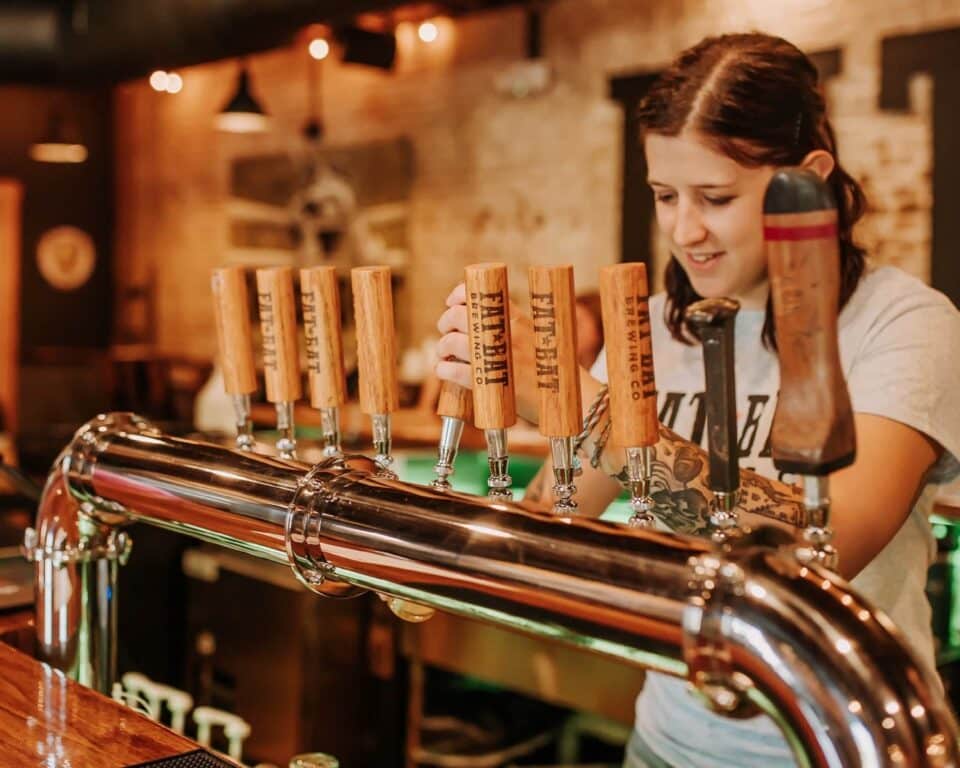When Iron Hill Brewery & Restaurant opened up their Phoenixville brewpub in 2006, they tapped Tim Stumpf to head up the brewery operations. He’s been there ever since. Tim recently gave me a tour of the brewery and we sat down over a sampling of his not yet tapped brews to learn about the life of a brewer.
Phoenixville Dish: What path did you take to become a brewer?
Stumpf: I was fortunate. Iron Hill opened up their first brewpub in Newark while I was going to the University of Delaware. I started out in the restaurant as a server trying to make some money and didn’t care much about beer at that point. Eventually I became a manager in the restaurant and then started helping the brewer. That was thirteen years ago. Since then I’ve worked with all the Iron Hill brewers. When I accepted the promotion to head up the brewpub here in Phoenixville, Iron Hill sent me to a brewing school, American Brewer’s Guild up in Vermont.
PD: How many Iron Hill locations are there now?
Stumpf: We have eight locations now. We were number six here in Phoenixville.
PD: How much autonomy does each brewer have?
Stumpf: This must be one of the best brewing jobs in the world. We have five brews that are considered our house brews. These five beers you can find in all the Iron Hill locations. We go through a painstaking process to make sure they taste the same at each pub. Beyond those five, I am able to choose the beers and play. Like last weekend, we had 16 beers on tap, 11 of which were my own creation.
PD: Tell me about Hoppopotamus?
Stumpf: My assistant and I had a specific beer in mind. There’s a beer out in California called Arrogant Bastard (brewed by Stone Brewing Co.) that we both enjoyed. We wanted to make a beer like that. We invited our first beer mug club member to come in and work with us on a new beer. He wanted to name this beer after his wife and have it for her birthday. So we called it Red Cindy. Everyone loved the beer and wanted us to make it again and again. The Red Cindy name had passed and we wanted a new name that would describe the hoppiness. We wanted an obnoxious name and we eventually came up with Hoppopotamus and that kind of stuck. But it started out as Red Cindy.
PD: How would you differentiate IH?
Stumpf: All our beer is brewed right here. I should say most of the beer is brewed here, though we have a handful of products not made here. Some very special high-end beers are sold in corked wine bottles, our most special stuff. One brewer works on a special brew and we’ll all get together and run a manual bottling process (those particularly bottles were not made here).
PD: Tell me about your winning entries in the Great American Beer Festival.
Stumpf: We all enter our most special beers in the Great American Beer Festival every year. We’ve won two medals. Two beers that were brewed right here, and those are the most special to me. The first gold medal we won for our Schwarzbier, which is a German-style dark lager. The other is Roggenbier, which is German for rye beer. This is an unfiltered rye beer, dark with a spiciness.
PD: What are the trends you are seeing in brewing today?
Stumpf: The Americanization of beers is trending. Most beers originated in Europe but the Americans have taken them and put their own spin on them. When you see something called an American Belgian that usually means there is more hops. Americans love their hops and that’s great.
There’s also a growing trend of nano breweries. A number of extremely small brewpubs opening up. These places make small quantities—homebrew-sized—five gallon at a time. They brew some really special products, with interesting ingredients like hazelnut and lemongrass—really bizarre stuff. They can do such small projects and there’s a mystique about the beers because they are so limited. Somebody will say, “I had this fantastic thing but it’s all gone.” Brewing trends seems to start on the West Coast and migrate this way. Portland, Oregon probably has a hundred of these nano breweries already.
The third trend, and this one is local, is collaboration. A recent example is this: Our brewer from the Media location worked with the brewers in Ithaca, New York. He drove up there and they made a special batch—they used our recipe but fermented with their yeast for a special brew. I’ve done collaboration with other Iron Hill brewers. We do some fun stuff together.
PD: So what do you have coming up?
Stumpf: Early autumn starts on the 21st of July. This is fun because we’ll finally tap our two most popular beers. Our Oktoberfest is a strong German-style amber lager that is 7%. It has a strong, sweet, bready, caramel taste. There’s hints of toffee and nuts in it and it has a clean finish. We’ll also have our Pumpkin Ale. The ales are more complex, rounder and fuller. We use pumpkin meat and pumpkin spices—China cinnamon, allspice, nutmeg, ginger and mace cloves. The best way to get the spice to come out is you steep the spices in there right after the boil just like iced tea.
PD: Final question. If you did not end up in the brewing business, what do you think you’d end up doing?
Stumpf: I’ve only ever worked in restaurants. (He contemplates this for awhile.) Ah, in college I took mechanical engineering so I might have ended up designing these types of buildings and breweries if I’d not ended up doing this.
Find Iron Hill Brewery & Restaurant of Phoenixville at 130 East Bridge Street or online at www.ironhillbrewery.com/phoenixville.



